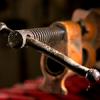I make lots of mistakes; more than most. I don't get things perfect. My time for woodworking is limited and my goal is to create something. I have no goal to become a hand tool woodworker. It's a means to an end. I choose to use hand tools because they are quiet and effective but what matters to me is the thing I'm making and the things I learn in the process. My practice is in the doing.
Don't get me wrong. I sometimes practice briefly to "warm up" if I haven't done something in a while and I practice to learn new techniques. But once I know enough to get rolling, I focus on doing it.
-- Dan Rode
"We are what we repeatedly do. Excellence, then, is not an act, but a habit." - Aristotle





 Reply With Quote
Reply With Quote




